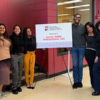State System will ‘Transform’ Itself to Expand Educational Opportunities for Students

Posted by: Elizabeth Richardson on January 17, 2019, No Comments
Pennsylvania’s State System of Higher Education will transform itself, with the member universities working more closely together to expand educational opportunities for students while reducing the costs with which they operate, Chancellor Dan Greenstein said today in delivering his first State of the System address.
“In a transformed system, our universities stop competing on every dimension. Instead, they organize to leverage their enormous collective operating scale, to utilize their tremendous collective talent in ways that extend and expand opportunities for all,” Greenstein said. “In a transformed system—a sharing system—every student on every campus has access to the full breadth of academic programming at every other campus across the system.
“To future students thinking about where to pursue their degree, hear me on this: in a transformed system, we organize entirely around you and your success, rather than asking you to organize around us.”
Greenstein laid out his vision for the State System after being formally sworn in as the System’s fifth chancellor, a position he has held since September. Afterward, he detailed his recommendations to the Board of Governors at the beginning of its regular, quarterly meeting.
“We have been engaged in the System Redesign process for more than two years,” said Board Chair Cynthia D. Shapira. “We hired Dan Greenstein as chancellor to lead real transformation because of his vast knowledge of the higher education landscape and because of his strong interpersonal and executive skills. He has demonstrated all in his first five months on the job, and in the bold initiatives he outlined for us today.”
Shapira administered the oath of office to Chancellor Greenstein during the brief ceremony that preceded his inaugural address. Governor Tom Wolf and several campus representatives welcomed the new chancellor with individual remarks.
“Dr. Greenstein comes to the State System at a time of tremendous challenge and tremendous opportunity,” said Governor Wolf. “I was proud to participate in the selection of Dan as the new chancellor and I welcome the opportunity to work with him on a new vision of our public universities. We need a strong State System that provides every student with an affordable education, so they can succeed in Pennsylvania.”
Joar Dahn, president of the Community Government Association at Bloomsburg University of Pennsylvania and one of three students serving on the Board of Governors, talked about the chancellor’s campus visit in the fall, when he met with students, faculty and staff.
“He connected in a real and meaningful way with those with whom he met,” Dahn said. “You could sense his passion for students, and his commitment to helping to ensure their success – our success.”
“Chancellor Greenstein is off to an excellent start; and, on behalf of the State System faculty, we look forward to working with him to make our system and our universities operate at their full potential in order that we may meet the System’s mission of providing an affordable, high-quality education,” said Dr. Kenneth Mash, president of the Association of Pennsylvania State College and University Faculties (APSCUF), the faculty union.
Speaking on behalf of the university presidents, Dr. Michael Driscoll, president of Indiana University of Pennsylvania, called Greenstein a “different” kind of leader, citing both his willingness to listen to other points of view and his unbridled enthusiasm for the job.
“Starting with his very first meeting with the Council of Presidents, he recognized that our experience was valuable. He floated some of his ideas and asked our opinions,” Driscoll said. “When we sometimes disagreed with his thoughts, rather than ignoring us, or worse, he modified his thinking. He promised to visit all fourteen State System universities, then he went and actually did it – within his first two months on the job.”
Jeff Smith, a trustee at Slippery Rock University of Pennsylvania and president of the Pennsylvania Association of Councils of Trustees, which represents all of the trustees from the 14 State System universities, said he and his fellow trustees “are grateful for the time Chancellor Greenstein already have given us, and for his invitation to participate in the System Redesign process. We welcome the opportunity to contribute to this important endeavor.”
Greenstein went on a 14-campus tour shortly after assuming the role of chancellor, spending a day at each of the universities. During those visits, he met with hundreds of students, faculty, staff and alumni, as well as with community and business leaders, to listen and to learn about the System and to start to develop a plan for its future. He learned a lot, he said.
“What I found was an amazing collection of institutions, populated by incredible people – students, faculty and staff who take quite seriously why they are there and who have immense pride in our mission,” said Greenstein. “I found universities that provide the kind of engaging experiences you see at the best liberal arts colleges, only at a public university price. I found universities that are unique in the educational programs they offer. I found universities that are responsive to changing societal needs.
“I found universities that house some of the most innovative practices I’ve seen in higher education—and I’ve seen a lot in a 35-year career—much of it self-consciously located on the leading edge. In all these ways, our universities exemplify what public higher education is and ought to be.”
He also found enormous challenges facing the State System; a reality common in higher education today.
“We are facing significant challenges – challenges that are present across U.S. public higher education, and that are concentrated in super-high doses here in Pennsylvania,” Greenstein said. “Lagging public investment forces tuition increases, which depress student enrollments, which are tough anyway in a state where the traditional high school population is contracting and where there are more seats in higher education than there are high school graduates to fill them.”
The System must do something it has never done before, he said, and “align around a shared vision and pursue it together.”
“I know we can alter the path we are on. We must,” said Greenstein. “And let me be crystal clear on this point; my optimism for the future? It’s not fueled by fear of failure. It’s grounded in the accomplishments of our history, and the passion, the energy and the talent of our people.”
Transforming the System will include the universities combining more of their business and administrative functions to become more cost efficient; partnering with K-12 schools and two-year colleges to develop new “credentialing pathways” to meet high-demand workforce needs; “doubling down” on student retention; and doing better with students who have been historically underserved by higher education and with adult learners who want to return to college to complete the degrees they began years ago or to reskill or upskill so they may continue to develop professionally and build sustaining careers.
“This kind of transformation requires investment,” Greenstein said. “We’re not going to cut our way into a successful future. We’ve tried it; others have tried it; it doesn’t work.”
That will mean not only reorganizing and reprioritizing existing resources, but also “exploring a whole new generation of public-private partnerships in virtually every aspect of our enterprise” and “ramping up” fundraising efforts, said Greenstein.
“We must make our case to elected officials—demonstrating the importance of public investment in higher education with a prospectus that is too compelling, too critical to the state’s economic and social well-being, to ignore,” he said. “We must be willing to look beyond the system for evidence-based practices that return good results.”
To best serve every student in Pennsylvania, all of the higher education sectors in the state must work together, Greenstein said.
“We must partner with the state and with Pennsylvania’s other higher education providers—the state-related universities, the community colleges, the independents,” he said. “Why? Because the higher education ecosystem in this state is broken—unsustainable in its current form. Left unattended to, it will fail us—all of us, all of Pennsylvania.
“We cannot as a single part of that ecosystem mend it. But we can and we must participate and even lead in an effort to find reliable, lasting, and—God willing—timely solutions that ensure sustainable, affordable, effective educational pathways run seamlessly for Pennsylvanians from their cradles through their careers.”
The task ahead won’t be easy, but is achievable, Greenstein concluded.
“I’m not talking about making modest adjustments to our enterprise; we won’t tweak our way out of this,” he said. “The challenges we face are too great; the stakes, too high. What I’m talking about is fundamental transformation and redesign. As daunting as it might sound, this kind of transformation is essential if the universities of this State System are to continue as critical assets of the commonwealth, as engines of economic development and social mobility, as vital and contributing parts of communities across Pennsylvania.
“This is our mission. This is our collective destiny. And I have no doubt, we will succeed—together.”
Pennsylvania’s State System of Higher Education comprises 14 public universities, which combined enroll the largest number of Pennsylvania residents among all four-year colleges and universities in the Commonwealth. With nearly 100,000 degree-seeking students and thousands more enrolled in certificate and other career-development programs, the State System is a vital contributor to the Pennsylvania economy, generating an estimated $6.7 billion of economic activity annually. Collectively, the State System universities offer more than 2,300 degree and certificate programs in more than 530 academic areas. The universities have nearly 800,000 living alumni, the vast majority of whom reside in Pennsylvania.
The State System is engaged in a System Redesign, which began with a top-to-bottom review of the universities and the Office of the Chancellor. As a result of that review, the Board established three priorities: ensuring student success; leveraging the universities’ strengths; and transforming the System’s governance structure. The Board also affirmed its commitment to ensuring the long-term sustainability of all 14 institutions within the System so that each may continue to serve students, its region and the Commonwealth. To view regular updates of the redesign, go to http://systemredesign.passhe.edu.
The State System universities are Bloomsburg, California, Cheyney, Clarion, East Stroudsburg, Edinboro, Indiana, Kutztown, Lock Haven, Mansfield, Millersville, Shippensburg, Slippery Rock and West Chester Universities of Pennsylvania. The universities also operate branch campuses in Oil City (Clarion), Freeport and Punxsutawney (IUP), and Clearfield (Lock Haven), and offer classes and programs at several regional centers, including the Dixon University Center in Harrisburg and in Center City in Philadelphia.
To view Chancellor Greenstein’s bio, go to: www.passhe.edu/inside/Pages/Chancellor%20Greenstein.aspx
Search
Recent Posts

Julianna and Wayne Bolt Art Contest Winners Selected for the 29th Annual Martin Luther King Jr. Celebration
December 10, 2025 - Read more

ESU Hosts 8th Annual Dr. Barbara G. Collins Social Work Professional Development Day
December 4, 2025 - Read more

ESU Professor Elected to American Society of Plant Biologists Steering Committee
November 25, 2025 - Read more

